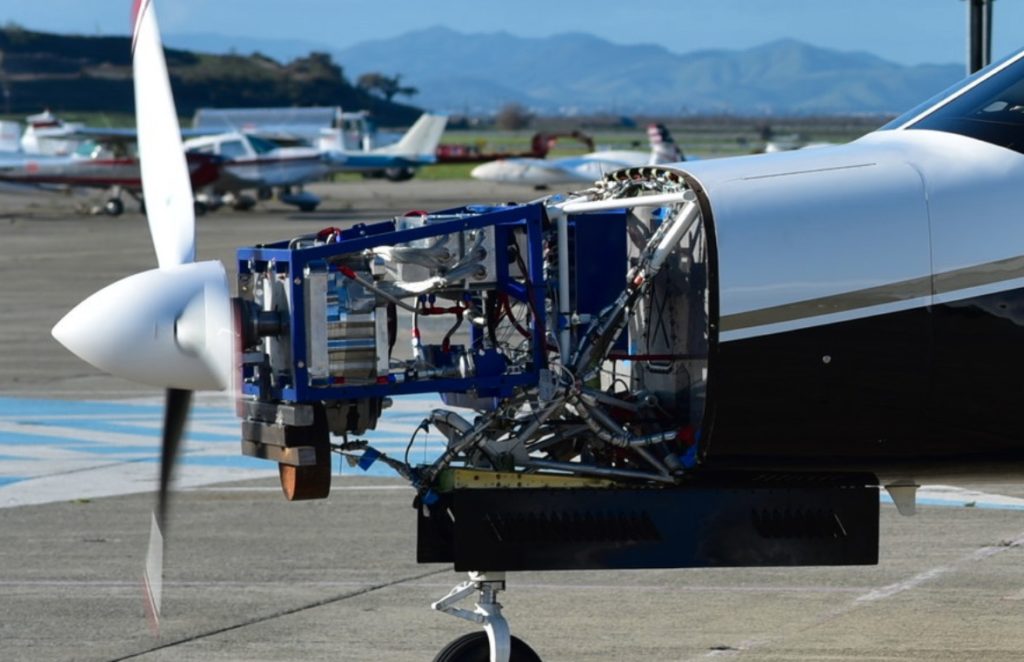Hydrogen for fuel cell aircraft can be produced locally from renewable energy. That message is buried in today’s press release from ZeroAvia, a new company that emerged from stealth mode to demonstrate a fuel cell drive train for medium sized airplanes. Pictured here is ZeroAvia’s test mule, a Piper M-Class 6-passenger airplane. The drive train is slated to be made available in 2022 to airplane manufacturers.
There are battery electric airplanes which have been demonstrated. Small trainer airplanes are on sale, I believe. This airplane is a little larger than those and will obviously fit into a different niche.
ZeroAvia’s press release![]() makes the case that the most practical way to enable zero emission aircraft is with fuel cells. The target airplane will handle 300-500 miles of flying range, with 20 passengers. It is envisioned to be an economically feasible solution for using smaller local airports for point-to-point travel – like an air taxi.
makes the case that the most practical way to enable zero emission aircraft is with fuel cells. The target airplane will handle 300-500 miles of flying range, with 20 passengers. It is envisioned to be an economically feasible solution for using smaller local airports for point-to-point travel – like an air taxi.
It’s about energy storage to weight ratios. For fuel cells to make sense in this application, the energy stored with hydrogen has to be greater than can be stored in a battery pack of the same size and weight. Airplanes are strict about energy capacity and weight. Therefore, embedded in ZeroAvia’s is the belief that battery packs will not provide a high enough energy density any time soon for airplanes.

Since the drive train is ZeroAvia’s focus, let’s zoom in on the picture they supplied and analyze what’s here.
First – the propellor is in motion, meaning this airplane is operational at least to the degree of taxiing around an airport. The press release says they’ve conducted test flights.
It looks like immediately behind the propellor is an electric motor, with no gearing between the motor and the propellor shaft. Immediately behind that is what looks like an inverter (motor controller) with cables connecting it with the motor. I’m wondering about the color choices in the wiring harness, since I understood it is required to use orange cables for high voltage wires so that technicians know which cable is dangerous.
Behind that is a blue box. Might that be the fuel cell stack?
Besides the motor and the inverter, there are three or four major components that must exist:
- Hydrogen storage tanks — most likely in the wings or whereever the gas tank is in this airplane
- Fuel cell stack
- Overall system control electronics, as well as avionics in the cockpit
- Small battery pack to buffer energy from fuel cell for driving the motor
The area immediately behind the engine compartment could hold some of those items. It’s not clear from the picture where all those items are located.
ZeroAvia describes their addressable market as:
500-mile flights to serve the short-haul and commuter air travel markets, which make up nearly half the commercial flights worldwide. … smaller zero-emission aircraft will be able to achieve similar per-seat economics as today’s large regional jets, allowing economical use of smaller local airports for point-to-point travel with virtually no security lines or delays, and a much more pleasant overall flying experience.
ZeroAvia
Additionally they’re looking to target air cargo, air taxi, and agriculture use cases. Over time they may target other types of air craft.
ZeroAvia intends a rather different business model, namely:
ZeroAvia will lease the drivetrain to customers and provide fuel and maintenance as part of its power-by-the-hour model, in which customers pay only for the hours that they use the drivetrain. This model emulates engine leasing options already popular in the aviation market.
ZeroAvia
With this sort of airplane air travel could be handled differently than today. Instead of flying in a big jet to a regional airport, we could fly to a local airport closer to the destination.
- The USA should delete Musk from power, Instead of deleting whole agencies as he demands - February 14, 2025
- Elon Musk, fiduciary duties, his six companies PLUS his political activities - February 10, 2025
- Is there enough Grid Capacity for Hydrogen Fuel Cell or Battery Electric cars? - April 23, 2023
- Is Tesla finagling to grab federal NEVI dollars for Supercharger network? - November 15, 2022
- Tesla announces the North American Charging Standard charging connector - November 11, 2022
- Lightning Motorcycles adopts Silicon battery, 5 minute charge time gives 135 miles range - November 9, 2022
- Tesla Autopilot under US Dept of Transportation scrutiny - June 13, 2022
- Spectacular CNG bus fire misrepresented as EV bus fire - April 21, 2022
- Moldova, Ukraine, Georgia, Russia, and the European Energy Crisis - December 21, 2021
- Li-Bridge leading the USA across lithium battery chasm - October 29, 2021











